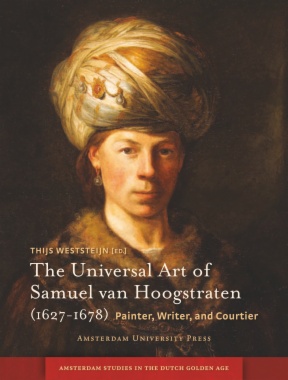Samuel van Hoogstraten was not only one of Rembrandt’s most successful pupils but also a versatile painter in his own right. His experiments in optical illusion also attracted the interest of the natural scientists of his time, and he wrote some of the first Dutch novels, plays, and a treatise on painting. This rich interdisciplinary study examines how van Hoogstraten understood the relationship between art, literature, and science and how these reflected the general views of his time. Bringing to the fore hitherto unknown works, the book is an important contribution to our understanding of van Hoogstraten’s life and art.
- The Universal Art of Samuel van Hoogstraten
- Contents
- Preface: Approaches to a Multifaceted Master
- Where are we now: Van Hoogstraten’s writings
- Van Hoogstraten’s paintings
- This book
- Notes
- Prolog: Samuel van Hoogstraten and the Golden Age of Dutch Art, Literature, and Science: The Present Book and Future Research
- Rembrandt’s studio
- The art of deceit
- Van Hoogstraten as a cosmopolitan courtier
- The history of knowledge
- Notes
- Chapter 1 – Van Hoogstraten’s Theory of Theory of Art – Jan Blanc
- Problems
- ‘Theorie’
- Rules
- ‘Teorica’
- Lucri causa’
- Craftsmanship
- Rhetoric
- Conclusion: a practical and personal theory of art
- Notes
- Chapter 2 – Paradoxical Passages: The Work of Framing in the Art of Samuel van Hoogstraten – Celeste Brusati
- Setting the pictorial stage
- Feigned frames: looking at the subject of painting
- Looking in and looking through
- Framing the threshold
- Perspectives in a box
- Framing and temporality
- Notes
- Chapter 3 – The Young Samuel van Hoogstraten, Corrected by Rembrandt – Ben Broos
- Versteegh, De Claussin and His de la Salle
- His master’s hand
- The first works
- From study to preparatory study
- An interesting document
- Notes
- Chapter 4 – “Zwierich van sprong”: Samuel van Hoogstraten’s Night Watch – Paul Taylor
- Chapter 5 – Samuel van Hoogstraten’s Personal Letter-Rack Paintings: Tributes with a Message – Michiel Roscam Abbing
- Introduction
- Brusati’s theory of self-representation
- The first owners of personal letter racks
- There is more to it than ‘marketing strategy’
- Personal work as tribute
- Letter Rack with a Play’ by Cowley and a Letter Addressed to Van Hoogstraten
- From a personally accented letter rack to a general type
- Conclusion
- Notes
- Chapter 6 – A Pledge of Marital Domestic Bliss: Samuel van Hoogstraten’s Perspective Box in the National Gallery, London – Herman Colenbrander
- The interior
- Looking through the peephole on the right
- Looking through the peephole on the left
- Notes
- Chapter 7 – Van Hoogstraten’s Success in Britain – Fatma Yalcin
- Van Hoogstraten’s trompe-l’oeils
- Van Hoogstraten’s travels
- Van Hoogstraten in Britain
- Van Hoogstraten’s columns
- Van Hoogstraten’s patrons?
- Appendix
- Notes
- Chapter 8 – Samuel van Hoogstraten, the First Dutch Novelist? – Thijs Weststeijn
- Pastoral writings and novelistic works in Dutch
- Intention
- What are these books?
- Literature and scholarship in the vernacular
- Horror, magic, and violence
- Impact
- Conclusion
- Appendix
- Fragment 1 (pages 23-25):
- Fragment 2 (pages 14-15):
- Fragment 3 (pages 146-149):
- Notes
- Chapter 9 – Great Respect and Complete Bafflement: Arnold Houbraken’s Mixed Opinion of Samuel van Hoogstraten – Hendrik J. Horn
- Arnold Houbraken as custodian of his teacher’s intellectual legacy
- Arnold Houbraken as alleged plagiarist of his teacher’s biographies
- Arnold Houbraken and his teacher as related but distinct thinkers
- Arnold Houbraken as exacting critic of his teacher as artist
- Conclusion
- Notes
- Appendix – Arnold Houbraken’s references to Samuel van Hoogstraten and his ‘Introduction to the Academy of Painting’ – Edited and Translated by Hendrik J. Horn
- Bibliography
- Bibliographical Abbreviations
- Manuscripts and Archival Documents
- Printed Sources and Studies
- List of Illustrations
- About the Authors
- Index

